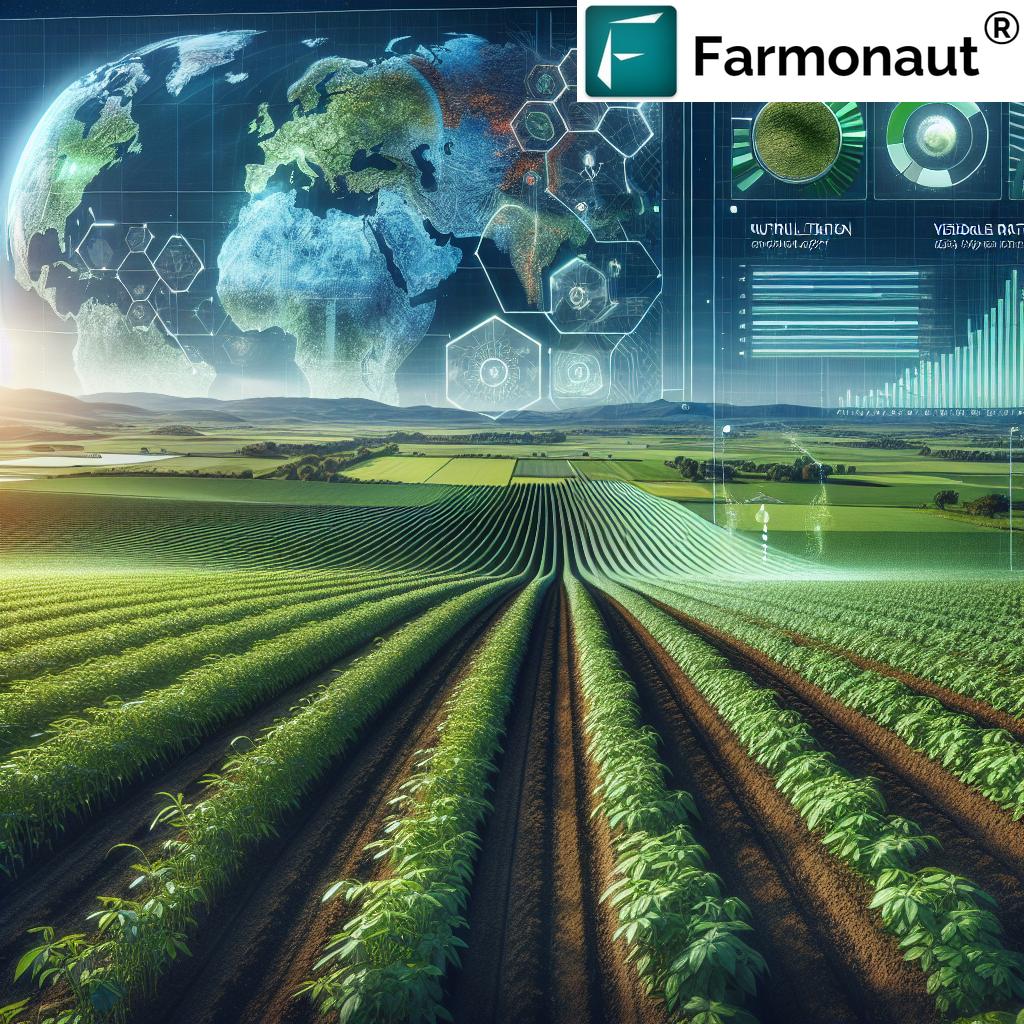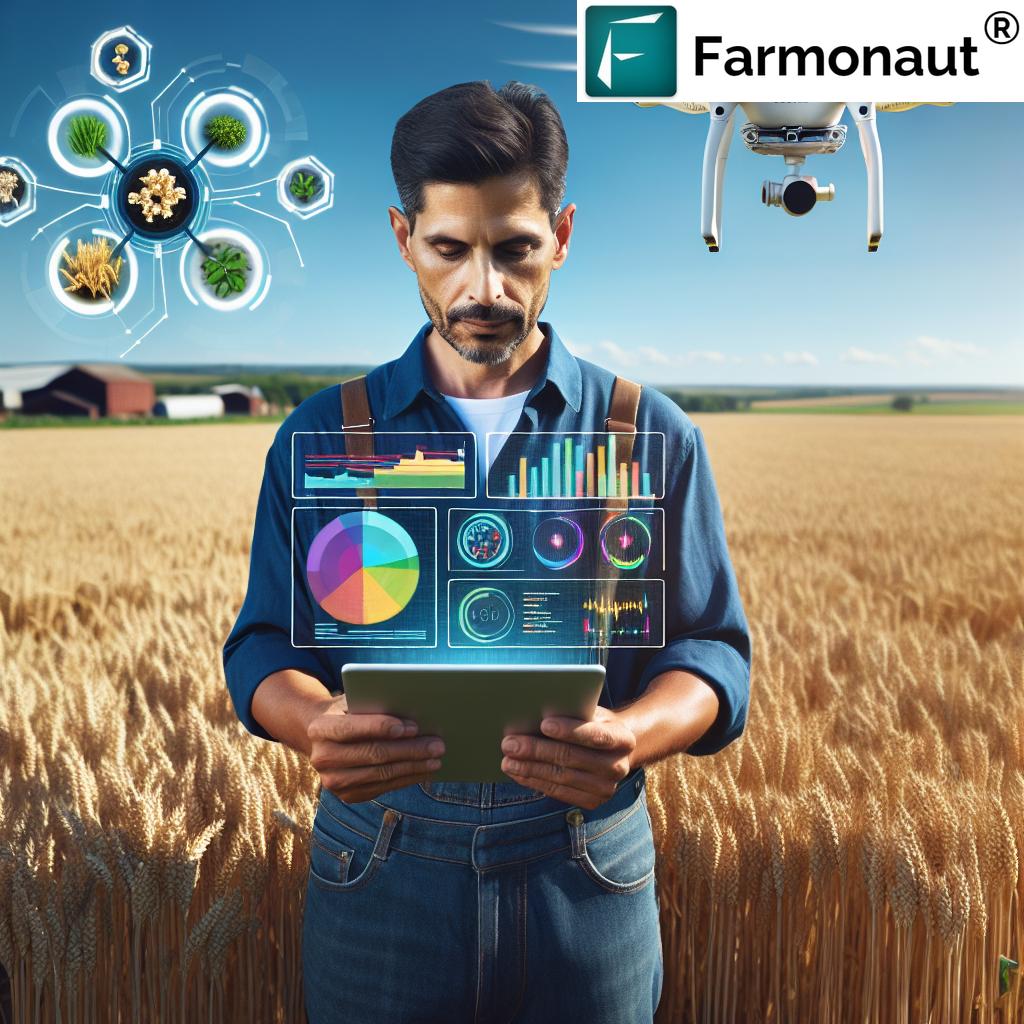Revolutionizing Agriculture: How Precision Farming and Agrochemical Innovations Are Shaping Global Food Security

“The global agrochemicals market is projected to reach USD 282.2 billion by 2028, driven by precision farming technologies.”
In an era where global food security stands at the forefront of international concerns, we find ourselves at the cusp of an agricultural revolution. As the world’s population surges past 8 billion, the demand for innovative solutions to feed this growing populace has never been more pressing. At Farmonaut, we are witnessing firsthand how precision farming and agrochemical advancements are reshaping the landscape of modern agriculture.
The global agrochemicals market is on an unprecedented growth trajectory, with projections indicating a staggering value of USD 282.2 billion by 2028. This remarkable expansion, from USD 235.2 billion in 2023, represents a compound annual growth rate (CAGR) of 3.7%. But what’s driving this surge, and how is it impacting global food security?
The Driving Forces Behind Agrochemical Market Growth
- Rising global population
- Increased food demand
- Agricultural intensification
- Limited arable land
These factors collectively underscore the critical role of agrochemicals in enhancing crop yields, protecting produce, and ensuring food quality. As we delve deeper into this topic, we’ll explore how precision farming technologies and sustainable agriculture practices are at the forefront of this revolution.
Precision Farming: A Game-Changer in Modern Agriculture
Precision farming stands as a testament to how technological integration can transform traditional agricultural practices. By leveraging advanced tools and data-driven insights, farmers can now optimize their operations like never before.
Key Components of Precision Farming:
- Soil Sensors: Providing real-time data on soil health and nutrient levels
- AI-driven Analytics: Offering predictive insights for crop management
- Multispectral Imaging: Enabling detailed crop health monitoring
- Autonomous Delivery Systems: Enhancing efficiency in resource application
These technologies collectively contribute to optimizing resource usage, improving soil productivity, and minimizing environmental impacts. The precision approach ensures that agrochemicals are applied in the right amounts, at the right time, and in the right places – a concept known as the “4Rs” principle.
The 4Rs Principle: Revolutionizing Agrochemical Application
The 4Rs principle – Right Source, Right Rate, Right Time, and Right Place – is transforming how we approach fertilizer and pesticide application. This methodology not only enhances crop yield but also addresses environmental concerns related to overfertilization.
| Year | Projected Market Value (USD Billion) | Key Drivers | Regional Focus |
|---|---|---|---|
| 2023 | 235.2 | Population growth, Food demand | Global |
| 2025 | 252.8 | Precision farming adoption, Sustainable practices | Asia, South America |
| 2028 | 282.2 | AI integration, Crop yield optimization | Asia, South America, Africa |
At Farmonaut, we’re proud to be at the forefront of this revolution, offering cutting-edge solutions that align perfectly with the 4Rs principle. Our satellite-based crop monitoring system provides farmers with invaluable insights, enabling them to make informed decisions about agrochemical applications.
Explore our advanced agri-solutions:
Innovations in Active Ingredients: Addressing Global Pest Management Challenges
As agricultural practices globalize, new challenges in pest and disease management have emerged. This has spurred a wave of innovation in active ingredients, with a focus on developing more effective and environmentally friendly solutions.
“With the world population exceeding 8 billion, agrochemicals play a crucial role in boosting productivity on limited arable land.”
Emerging Trends in Agrochemical Development:
- Biopesticides and bio-based solutions
- Nano-formulations for enhanced efficacy
- Target-specific pest control agents
- Integrated pest management strategies
These advancements are not only improving crop protection but also addressing concerns about environmental impact and food safety. At Farmonaut, we recognize the importance of these innovations and integrate them into our advisory systems to provide farmers with the most up-to-date recommendations.
The Rising Stars: Asia and South America in the Agrochemical Market
As we look at the global landscape of agrochemical market growth, two regions stand out prominently: Asia and South America. These areas are not just experiencing rapid economic expansion and population growth; they’re also becoming hotbeds for agricultural innovation and agrochemical consumption.
Asia: A Burgeoning Market for Agrochemicals
The Asian market for agrochemicals is experiencing unprecedented growth, driven by several factors:
- Rapid population growth increasing food demand
- Economic development leading to changing dietary patterns
- Government initiatives supporting agricultural modernization
- Adoption of precision farming technologies
Countries like India and China are at the forefront of this growth, with their vast agricultural sectors embracing modern agrochemical solutions to boost productivity. At Farmonaut, we’re seeing increased interest from Asian farmers in our satellite-based crop monitoring services, indicating a growing trend towards precision agriculture in the region.
South America: A Powerhouse of Agricultural Production
South America, particularly countries like Brazil and Argentina, represents a significant region for growth in the agrochemical sector. Projections indicate that the South American market could reach a staggering USD 73.2 billion by 2028.
Key factors contributing to South America’s prominence include:
- Vast areas of arable land
- Favorable climate conditions for agriculture
- Strong position in global oilseed production
- Increasing adoption of genetically modified crops
The region’s focus on crops like soybeans and corn, which require intensive agrochemical inputs, further fuels the market growth. Farmonaut’s technologies are particularly beneficial in these large-scale farming operations, offering comprehensive field monitoring and management solutions.

Technological Integration: The Future of Agrochemical Applications
The future of agrochemicals is inextricably linked with technological advancements. As we at Farmonaut continue to innovate, we’re seeing how the integration of various technologies is revolutionizing the way agrochemicals are used and managed.
AI and Machine Learning in Agrochemical Management
Artificial Intelligence (AI) and Machine Learning (ML) are transforming agrochemical applications by:
- Predicting optimal application times based on weather and crop data
- Identifying early signs of pest infestations or nutrient deficiencies
- Optimizing agrochemical formulations for specific crop needs
- Enhancing decision-support systems for farmers
Our AI-powered advisory system, Jeevn AI, exemplifies how these technologies can be harnessed to provide personalized, data-driven recommendations to farmers, ensuring optimal use of agrochemicals.
Experience the power of AI in agriculture:
Drone Technology and Precision Application
Drones are revolutionizing the way agrochemicals are applied, offering benefits such as:
- Precise and targeted application, reducing overall chemical usage
- Ability to reach difficult or hazardous areas
- Real-time crop monitoring for immediate response to issues
- Reduced labor costs and increased efficiency
At Farmonaut, we’re exploring ways to integrate drone technology with our satellite imagery services to provide even more comprehensive farm management solutions.
Sustainable Practices: Balancing Productivity and Environmental Stewardship
As the agrochemical industry grows, there’s an increasing focus on sustainable practices that balance productivity with environmental conservation. This shift is not just a trend but a necessity for long-term food security and ecological health.
Key Sustainable Practices in Agrochemical Use:
- Integrated Pest Management (IPM): Combining biological, cultural, and chemical methods to minimize pesticide use
- Precision Agriculture: Using technology to apply agrochemicals only where and when needed
- Organic and Bio-based Solutions: Developing and promoting eco-friendly alternatives to synthetic chemicals
- Circular Economy Approaches: Recycling and reusing agrochemical packaging and waste
At Farmonaut, sustainability is at the core of our mission. Our satellite-based monitoring system helps farmers reduce unnecessary agrochemical applications, promoting both environmental and economic sustainability.
The Role of Big Data in Optimizing Agrochemical Use
Big Data analytics is playing an increasingly crucial role in the agrochemical sector. By collecting and analyzing vast amounts of data from various sources, we can gain unprecedented insights into agricultural processes and optimize agrochemical use.
How Big Data is Transforming Agrochemical Applications:
- Predictive analytics for pest and disease outbreaks
- Soil mapping for targeted nutrient management
- Weather pattern analysis for optimal application timing
- Yield prediction models for resource allocation
Farmonaut’s platform leverages big data to provide farmers with actionable insights, helping them make informed decisions about agrochemical applications. Our API services also allow integration with other agricultural technologies, further enhancing the power of data in farming.
Harness the power of agricultural data:
Explore Farmonaut’s API
API Developer Docs
Regulatory Landscape and Its Impact on Agrochemical Innovations
The regulatory environment plays a crucial role in shaping the future of agrochemical innovations. As global awareness of environmental and health issues grows, regulations are becoming more stringent, driving the industry towards safer and more sustainable solutions.
Key Regulatory Trends Affecting Agrochemicals:
- Stricter environmental impact assessments
- Increased focus on residue limits in food products
- Promotion of integrated pest management strategies
- Incentives for developing bio-based alternatives
These regulations, while challenging, are also spurring innovation in the agrochemical industry. Companies are investing heavily in R&D to develop products that meet these stringent standards while maintaining efficacy.
The Future of Agrochemicals: Trends and Predictions
As we look towards the future, several trends are likely to shape the agrochemical industry:
- Nanotechnology: Development of nano-formulations for enhanced efficacy and reduced environmental impact
- Gene Editing: Creating crops with enhanced resistance, potentially reducing the need for certain agrochemicals
- Biostimulants: Growing market for natural products that enhance crop resilience and yield
- Digital Integration: Increasing use of IoT and AI in agrochemical management systems
At Farmonaut, we’re constantly evolving our technologies to stay ahead of these trends, ensuring that our users have access to the most advanced and sustainable agricultural solutions.
Conclusion: A New Era of Sustainable and Efficient Agriculture
The agrochemical industry stands at the threshold of a new era, one where precision, sustainability, and innovation converge to address the pressing challenges of global food security. As we’ve explored, the market is projected to reach new heights, driven by technological advancements and a growing global population.
The integration of precision farming technologies, sustainable practices, and innovative agrochemical solutions is not just reshaping the industry – it’s redefining the very future of agriculture. From the vast fields of South America to the burgeoning agricultural sectors in Asia, these advancements are making a tangible impact on crop yields, resource efficiency, and environmental stewardship.
At Farmonaut, we’re proud to be part of this agricultural revolution. Our satellite-based solutions and AI-driven insights are empowering farmers worldwide to make data-driven decisions, optimize their agrochemical use, and contribute to a more sustainable and food-secure future.
As we move forward, the challenge will be to balance the increasing demand for food production with the imperative of environmental protection. The agrochemical innovations we’ve discussed – from precision application technologies to bio-based solutions – will be crucial in striking this balance.
The future of agriculture is bright, efficient, and sustainable. By embracing these technological advancements and innovative approaches, we can ensure that the global agrochemical market not only grows in value but also in its capacity to nourish the world responsibly.
FAQs
- What is precision farming?
Precision farming is an agricultural management concept that uses technology to observe, measure, and respond to variability in crops. It involves using tools like GPS, sensors, and data analytics to optimize farming practices. - How do agrochemicals contribute to food security?
Agrochemicals play a crucial role in food security by enhancing crop yields, protecting crops from pests and diseases, and improving overall food quality and quantity. - What are the environmental concerns associated with agrochemical use?
Environmental concerns include soil and water pollution, impacts on non-target organisms, and potential contributions to greenhouse gas emissions. Modern agrochemical practices aim to mitigate these issues. - How is AI being used in agriculture?
AI in agriculture is used for predictive analytics, automated machinery operation, crop and soil health monitoring, and personalized farm management recommendations. - What is the “4Rs” principle in agrochemical application?
The 4Rs principle refers to applying the Right source of nutrients, at the Right rate, at the Right time, and in the Right place to optimize nutrient efficiency and minimize environmental impact.















